The Standard Inscription of Assurnasirpal II
As part of his transformation of Kalhu into a magnificent royal capital, Assurnasirpal II commissioned a vast new palace to serve as his residence in the city. The palace walls were lined with brightly painted relief TT sculptures illustrating war, hunting and religious scenes. Across the reliefs ran a cuneiform inscription telling of Assurnasirpal's victories and the founding of his new capital, and this its new palace. This inscription is now known as the "Standard Inscription" of Assurnasirpal.
A royal housewarming party
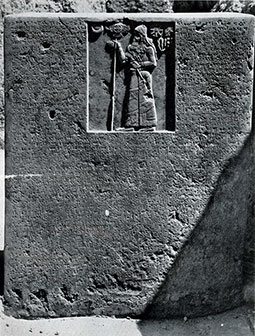
Image 1: This stela commemorates the inauguration of Assurnasirpal's Northwest Palace. Its description of a lavish feast has given it its modern name, the "Banquet Stela". The stela TT lay just a few metres from where Layard's excavations had ended a century before. It had been installed in a recess just outside the entrance to the throne room. The stela was excavated by the British School of Archaeology in Iraq TT in 1951 and is now in the collection of the museum in Mosul PGP ( ND1104). Photo: BSAI/BISI (1).
In 879 BC king Assurnasirpal II of Assyria celebrated the completion of his new palace (now known as the Northwest Palace) by hosting a party that lasted for ten days. 69,574 guests were invited - men and women from across the Assyrian realm, including 16,000 citizens of Kalhu and 5,000 visiting dignitaries. In the company of Aššur and all the other gods they feasted on thousands of sheep, oxen and deer, tens of thousands of birds and fish, eggs, hundreds of containers of grains, vegetables, bread, cheese, nuts and fruit, garnished with hundreds of jars of honey and spices. To wash it down, the guests were given 10,000 jugs of beer and 10,000 skins of wine. They were bathed, anointed with oil, and sent home "in peace and joy". Assurnasirpal commemorated this lavish feast in an inscribed stela (the so-called Banquet Stela) set up near the throne room of his new palace (Image 1) (2).
Among those invited to the celebrations were representatives from Gilzanu PGP , Suhu PGP and Patina PGP . Representatives from these regions are also depicted upon the Black Obelisk bringing tribute to Assurnasirpal's son and successor Shalmaneser III. Inside the royal palace, these lucky guests would have seen walls decorated with carved bas-reliefs TT and inscribed with cuneiform TT text (Image 2). But what did the inscriptions say?
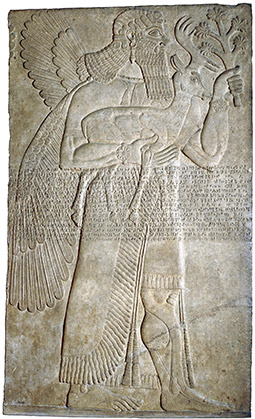
Image 2: A relief from Assurnasirpal II's Northwest Palace, inscribed with the text of the Standard Inscription. The protective spirit once guarded the entrance to the royal throne room. BM 124560. View large image on British Museum website. © The Trustees of the British Museum.
What is the Standard Inscription?
The Standard Inscription is not an object in its own right, but rather a single, standardised cuneiform text written in Akkadian, which was carved out many times in celebration of Assurnasirpal's accomplishments. It ran to 22 lines of script altogether. The first five lines assert the king's credentials:
Palace of Assurnasirpal, vice-regent of Aššur, chosen one of the gods Enlil PGP and Ninurta, beloved of the gods Anu PGP and Dagan PGP , destructive weapon of the great gods, strong king, king of the universe, king of Assyria, son of Tukulti-Ninurta PGP , great king, strong king, king of the universe, king of Assyria, son of Adad-nerari PGP , great king, strong king, king of the universe, king of Assyria; valiant man who acts with the support of Aššur, his lord, and has no rival among the princes of the four quarters, marvellous shepherd, fearless in battle, unopposable mighty floodtide, king who subdues those insubordinate to him, he who rules all peoples, strong male who treads upon the necks of his foes, trampler of all enemies, he who smashes the forces of the rebellious, king who acts with the support of the great gods, his lords, and has conquered all lands, gained dominion over all the highlands and received their tribute TT , capturer of hostages, he who is victorious over all countries... (3).
The next nine lines report the extent of his victories, stretching from Mount Lebanon PGP in the west to Armenia PGP in the east, and encroaching south into Babylonian PGP territory. The last eight lines tell how he rebuilt the city of Kalhu (and made it his capital), and settled there people from his newly conquered territories. He built a great palace, decorated with the finest woods and metals, and stone statues of the beasts of the mountains and the seas; then he filled it with booty.
Passages of text with very similar wording are found on other monumental inscriptions of Assurnasirpal. Together they reveal in splendid detail the accomplishments of one of the most important rulers in Assyrian history.
Text and image
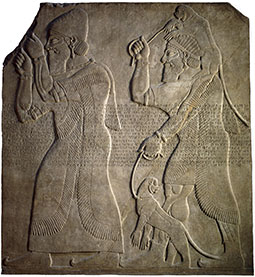
Image 3: The text of the Standard Inscription can be seen running across the fine detail of this relief (BM 124562) from the Northwest Palace's throne room. Here Syrians bring monkeys as tribute TT to the king. Compare the depiction of monkeys on Shalmaneser's Black Obelisk. View large image on British Museum website. © The Trustees of the British Museum.
Assurnasirpal had no qualms about having his Standard Inscription carved across the figures on the reliefs decorating his palace walls (Image 3). The gods and the king himself would have text written across their visual representation. In the cuneiform world, this meant the words being carved into the bodies of the figures. It was a deliberately chosen technique intended to wed text and image. The figures were all designed to perform a function, and to communicate a message. Likewise, the king's carefully composed text does the same. And the two are physically united.
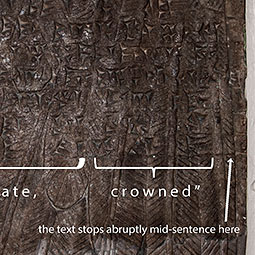
Image 4: The inscription on this slab stops abruptly, part-way through line 13 with the words "Encircler of the obstinate, crowned". It was due to continue "with splendour, fearless in battle ..." but the carver had run out of space. The inscription looks convincingly complete at first glance, but the scribes TT would have noticed the trick. A detail from relief BM 124530. View large image. Image: Jon Taylor for the Nimrud Project CC-BY-SA 3.0.
Study of the many duplicates of the inscription has revealed that a set amount of space was assigned for the inscription on each relief slab. The result was a harmonious visual appearance throughout the rooms. Sometimes the stone carver was unable to fit the full 22 line text in the allotted space. Examples are known where as few as the first 8 lines were carved. And occasionally the carver stopped in mid-sentence (Image 4).
Fragments of history
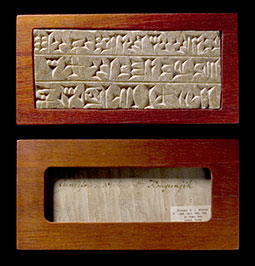
Image 5: A fragment of the Standard Inscription from Donald Wiseman's PGP collection, given to the British Museum in 2010. BM 2010,6022.19. View large image on British Museum website. © The Trustees of the British Museum.
Layard, the first excavator of Nimrud, realised that the text of Assurnasirpal's Standard Inscription was repeated frequently across many of the reliefs from his palace. However, excavations at this time were not concerned with the systematic collecting of archaeological material, and when the slabs were cut in preparation for transport, many of the copies of this standardised text were left behind. More than 400 copies of the text are known, and examples can be found in museums around the world. Other fragments were collected privately and some have subsequently come to light over the years. One example (BM 2010,6022.19) was given as a gift by Layard to one of his wife's relatives (Image 5). She gave it to her daughter, who in turn gave it to Donald Wiseman PGP . Wiseman himself was part of the British School of Archaeology in Iraq TT excavation team working at Nimrud in the 1950s. A second fragment (BM 136715) was collected by the Rev. S. C. Malan, a Biblical scholar and artist who visited Layard's excavations in June 1850. Malan's drawings illustrate Layard's Discoveries in Nineveh and Babylon (1853) (4). Both of these fragments are now in the British Museum collection.
However, more than half of the known examples of the Inscription are still in situ at Nimrud. Other monumental inscriptions were also left behind. Layard produced paper squeezes TT of some, and their text was later published on the basis of these squeezes. The squeezes have since perished, however, meaning that anyone who wishes to check what a particular inscription says must now visit the original object in situ. Many of these are underground, having been reburied by the excavators to protect them.
Content last modified: 18 Dec 2019.
References
- Wiseman, D.J. 1952. "A new stela of Aššur-naṣir-pal II", Iraq 14, pp. 24-44 (PDF available via JSTOR for subscribers), pp. plate 2, between pp.24-25. (Find in text ^)
- Grayson, A.K., 1991. Assyrian Rulers of the Early First Millennium BC: I (1114-859 BC) (Royal Inscriptions of Mesopotamia. Assyrian Periods. Volume 2), Toronto: University of Toronto Press, pp. 288-293, A.0.101.30 contains the full English translation of the Banquet Stela. (Find in text ^)
- Grayson, A.K., 1991. Assyrian Rulers of the Early First Millennium BC: I (1114-859 BC) (Royal Inscriptions of Mesopotamia. Assyrian Periods. Volume 2), Toronto: University of Toronto Press, pp. 275, A.0.101.23:1-5. (Find in text ^)
- Layard, A.H., 1853. Discoveries in the Ruins of Nineveh and Babylon, London: John Murray (free online edition via The Internet Archive). (Find in text ^)
Further reading
- Collins, P., 2008. Assyrian Palace Sculptures, Austin: University of Texas Press, pp. 29-61.
- Wiseman, D.J. 1952. "A new stela of Aššur-naṣir-pal II", Iraq 14, pp. 24-44 (PDF available via JSTOR for subscribers).
- Reade, J.E., 1983. Assyrian Sculpture, London: British Museum Publications, pp. 34-41.
- Mallowan, M.E.L., 1966. Nimrud and Its Remains, vols. I-II, London: Collins, pp. 57-73.
- Russell, J.M., 1999. The Writing on the Wall: Studies in the Architectural Context of Late Assyrian Palace Inscriptions, Winona Lake: Eisenbrauns, pp. 9-63.
Jonathan Taylor
Jonathan Taylor, 'The Standard Inscription of Assurnasirpal II', Nimrud: Materialities of Assyrian Knowledge Production, The Nimrud Project at Oracc.org, 2019 [http://oracc.museum.upenn.edu/nimrud/livesofobjects/standardinscription/]